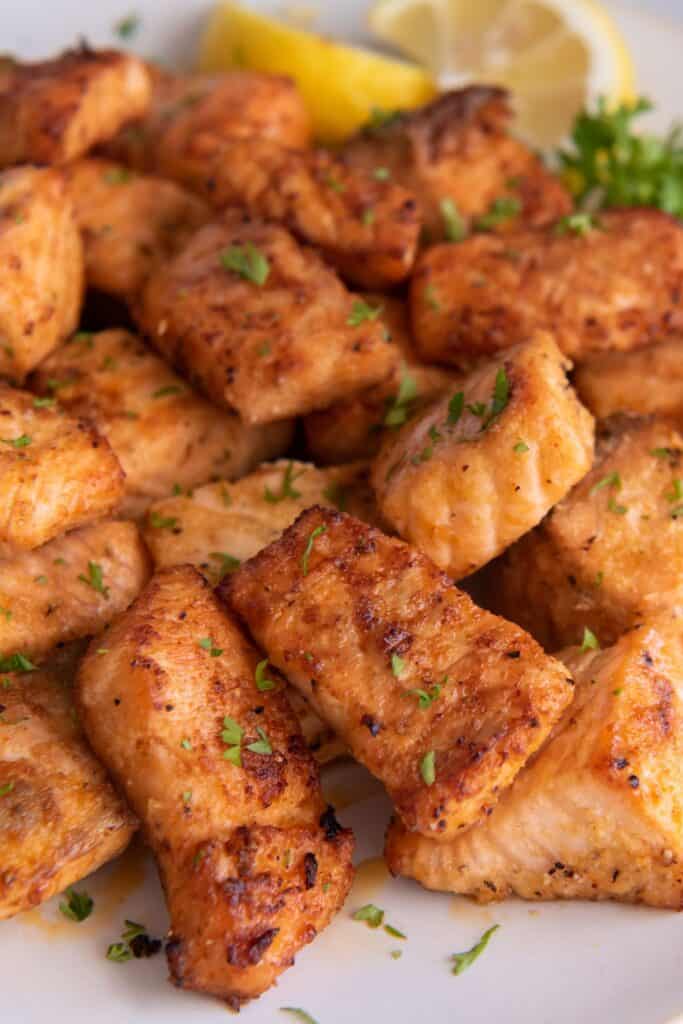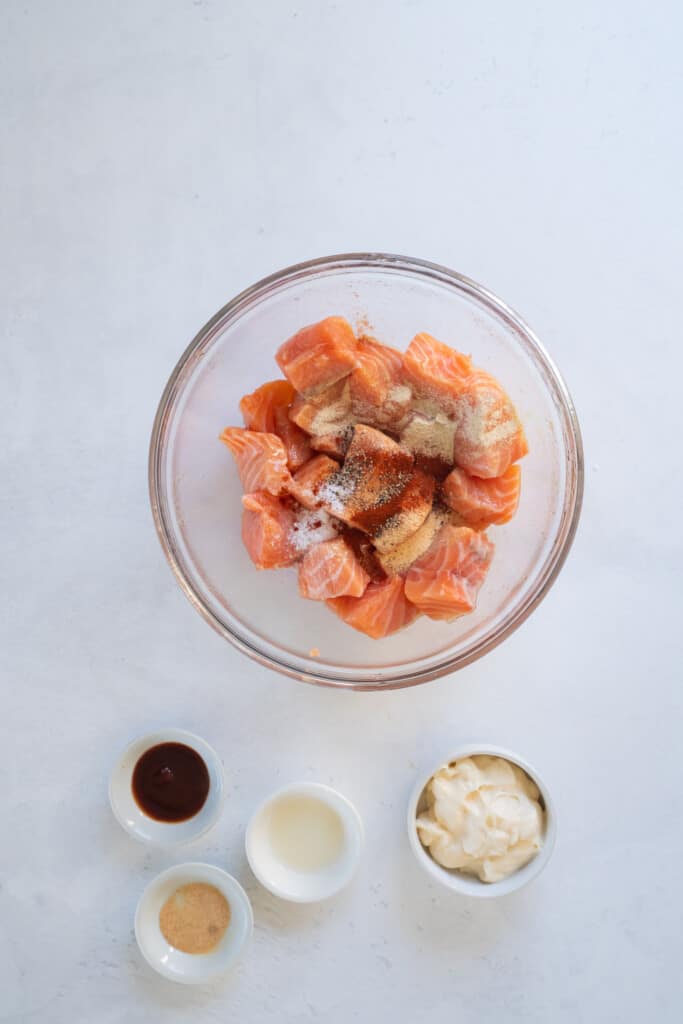My air fryer salmon bites are cooked to crispy, irresistible perfection that somehow gets even better in the sriracha dipping sauce! I use simple ingredients and bite-sized cubes for a quick dish my family always devours.

This post may contain affiliate links. If you click on a link and make a purchase, I may receive a small commission at no extra cost to you. For more information, please read my disclaimer.
My Favorite Recipe for Salmon Bites in the Air Fryer
One night, I had a salmon fillet in the fridge and wanted to figure out something yummy to do with it that didn’t involve a ton of prep. I wasn’t in the mood to broil, pan-sear, or grill the fish, so I thought I’d give air fryer salmon bites a try!
I cut the fish into 1-inch cubes and tossed them with olive oil and spices in a bowl, then let the air fryer work its magic. While the salmon bites cooked, I threw together a sriracha dipping sauce just for fun.
The salmon bites came out so crispy and caramelized on the outside but were still tender on the inside! Even my son Connor went back for seconds, which never happens with salmon. And my husband Ben couldn’t get enough of the sriracha dipping sauce.
And, if you love air fryer salmon recipes, try my recipes for air fryer salmon, air fryer salmon patties, frozen salmon in the air fryer, and air fryer teriyaki salmon.

Air Fry Salmon Bites Ingredients
- Salmon fillets – I either use skinless fresh salmon or thaw frozen fillets and remove the skin. I love salmon because it’s a great source of healthy Omega-3 fatty acids!
- Olive oil – I use olive oil, but any neutral oil or melted butter will work.
- Lemon juice – This is my favorite way to bring bright, fresh flavors to the salmon that balances the richness of the fish. I also use it in the sriracha dip.
- Garlic and onion powder – To add earthiness to the salmon and also give the dipping sauce extra punch.
- Smoked paprika – Adds a little color and a subtle smoky flavor that pairs so well with salmon. I use regular paprika if I don’t have it on hand.
- Salt and black pepper – Enhances the natural flavor of the salmon.
- Mayonnaise – This is my go-to for the base of the dip to make it creamy and smooth.
- Sriracha – To bring a little heat to the dipping sauce. I use ketchup in place of the sriracha for my kids.
How to Make Salmon Bites in the Air Fryer
A full printable version of this recipe with ingredient measurements is available at the bottom of this post.
STEP ONE: Cut the salmon into even 1-1½ inch cubes, then place them in a large mixing bowl.
STEP TWO: Preheat the air fryer to 390 degrees F.
STEP THREE: Drizzle the oil and lemon juice over the salmon. Sprinkle the fillets with the seasoning.
STEP FOUR: Use your hands or a wooden spoon to toss everything together until the bites are completely coated on all sides.

STEP FIVE: Transfer the salmon to the air fryer basket or tray, placing them in a single layer for even cooking, and air fry for 7-10 minutes, flipping it once until fully cooked.

STEP SIX: While the fish is cooking, combine the mayonnaise, sriracha, lemon juice, and garlic powder in a small mixing bowl. Whisk everything until it’s fully combined to create the dipping sauce.

Tips for the Best Air Fryer Salmon Bites Recipe
- I mix the salmon gently after adding the oil, lemon juice, and seasonings so I don’t break up the fish too much.
- If there’s excess moisture on the salmon, I’ll pat it dry with a paper towel to help everything stick.
- Cut the salmon into even 1-inch cubes so everything cooks at the same rate. I use a sharp knife and try to keep the pieces pretty close in size.
- I arrange the salmon bites in a single layer in the air fryer basket. If I need to make more, I cook in batches to avoid overcrowding the air fryer.
- Flip the bites halfway through cooking for even browning on all sides. I use tongs and turn them gently so they don’t break apart.

Air Fried Salmon Bites Variations and Substitutions
- If I’m in the mood for a little sweetness, I replace the olive oil with honey. I love dipping this version in the sriracha sauce for a burst of sweet and spicy flavor!
- For a kid friendly version of the dipping sauce, I swap out the sriracha for ketchup. My husband and I love the spicy sauce, and my kids can’t get enough of the ketchup one!
- I sometimes use sesame oil instead of olive oil for a wonderfully nutty twist on the flavor.
- When I want to dial up the heat, I’ll add some cayenne pepper to the seasoning mixture.
- I like to sprinkle the salmon cubes with sesame seeds right after cooking for a little extra texture and a really nice presentation.
What to Serve with Air Fryer Salmon Cubes
My favorite way to enjoy air fryer salmon bites is with some air fryer white rice drizzled with soy sauce (tamari or coconut aminos is great for gluten-free) or teriyaki sauce for tons of delicious flavor!
Salmon bites are also delicious with easy veggies like my air fryer baked potato, air fryer asparagus, and air fryer broccoli for a well-rounded meal.

Air Fryer Salmon Bites FAQs
How long to air fry salmon bites
The USDA recommends cooking salmon to 145 degrees F, but some people say salmon should only be cooked to 125 degrees F. Personally, I think air frying salmon bites at 390 degrees F for 7-10 minutes is just the right amount of time! I make sure the outside is crispy and that each bite is opaque all the way through.
How to reheat salmon bites in the air fryer
Salmon leftovers are so good the next day! To reheat salmon bites, I preheat the air fryer to 390 degrees F, lay the salmon pieces in a single layer in the air fryer basket, then cook for 3-4 minutes until they’re crispy and heated through.
Why are my air fryer salmon bites getting dark on the outside but are not at temperature?
This usually happens if the bites are too big or the air fryer is cooking unevenly. I make sure to cut my salmon into 1-inch or 1.5-inch cubes and arrange them in a single layer so the air can circulate properly to crisp up the outside while cooking the salmon bites all the way through.
How should I store leftover salmon bites?
I store my salmon leftovers in an airtight container in the refrigerator and eat them within 2 days. They reheat so well and taste great added to rice bowls, salads, or tucked into wraps for lunch!

Love air frying? Join my newsletter! You can also follow me on Facebook, Instagram, or join my free Facebook Air Frying Community.

Easy Air Fryer Salmon Bites
Equipment
Ingredients
- 1 pound salmon fillets skinless
- 1 tablespoon olive oil
- 1 teaspoon lemon juice
- 1 teaspoon garlic powder
- 1 teaspoon onion powder
- ½ teaspoon kosher salt
- ½ teaspoon smoked paprika
- ¼ teaspoon black pepper
Sriracha Dip
- ¼ cup mayonnaise
- ½-1 tablespoon sriracha or ketchup
- 1 teaspoon lemon juice
- ¼ teaspoon garlic powder
Instructions
- Cut the salmon into even 1-1.5-inch cubes and place them in a large mixing bowl. Preheat the air fryer to 390 degrees F.
- Drizzle the oil and lemon juice over the salmon and sprinkle it with the seasoning. Use your hands or a wooden spoon to toss everything together, coating the bites completely.
- Place them in a single layer in the air fryer basket, air frying them for 7-10 minutes, flipping once until they're fully cooked.
- While the fish is cooking, combine the mayo, sriracha, lemon juice, and garlic powder in a small mixing bowl and whisk until it's fully combined.
Notes
- Mix the salmon gently after adding the spices so it doesn’t break up the fish.
- If there’s excess moisture on the salmon, pat it dry with a paper towel before adding the oil and seasonings.
- Cut the salmon into even 1-inch cubes so everything cooks at the same rate.
- Arrange the salmon bites in a single layer in the air fryer basket so they cook evenly. Cook in batches if needed.
- Flip them halfway through cooking for even browning on all sides.
- Store leftovers in an airtight container in the refrigerator for up to 2 days.
- Reheat leftovers in a preheated air fryer at 390 degrees F for 3-4 minutes until they’re heated through.
Nutrition
This nutrition information is based on the exact products I used in this recipe. Brands and sizes of products could alter exact nutrition and should always be calculated independently.

